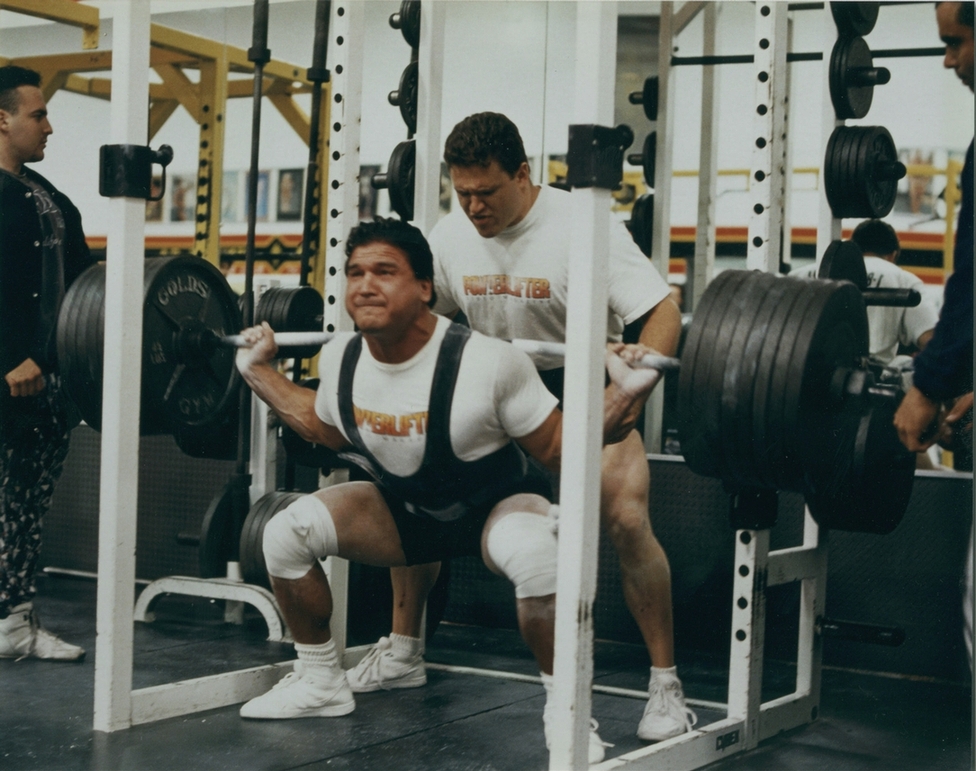

What is the Squat?
The parallel squat (shown to the left) is the most important lift in all of sports and the most efficient exercise in building strength. It incorporates back and leg strength, stability, and coordination. Almost every athlete can benefit from doing squats.
How do you do Squats?
Squats are done with a weighted bar on your shoulders, in the natural groove between the muscles, with your feet a little farther than shoulder-width apart. Keeping your back rigid at a slight arch and your head up, bend at the knees until your thighs are parallel to the ground. Pause momentarily at this position and ascend to your initial position. Squats should be done with a weight belt on and a spotter handy. The most important things to remember when doing a squat are to never let your head down or your back bend, and be sure to reach parallel, so the squat is more effective.

The Physics of the Squat
What makes squatting the most effective lift? The answer is the downward pull of gravity on the lifter. The squatter is essentially pushing directly against gravity. Gravity is a an attractive force that acts on every thing that has mass in the universe. Isaac Newton, famous physicist and mathematician, discovered the laws that govern this force. His law of universal gravitation states that:
Every particle in the Universe attracts every other particle with a force that is directly proportional to the product of their masses and inversely proportional to the square of the distance between them.
From this law, the the acceleration due to this force of gravity near the surface of the earth is approximately 9.8 meters per second squared. This means that if two object are dropped from the same height, they will hit the ground at the same time, regardless of how much they weigh(of course, one must neglect air resistance). This is how weight is defined. An objects weight is defined as the acceleration of gravity g multiplied by its mass m (mg). For example, a person having a mass of 50 kilograms(kg) would have a weight of 490 kg meters per second squared, or 490 Newtons(N). The acceleration of gravity constant was found using Newton's famous three laws of motion:
1. In the absence of external forces, an object at rest remains at rest and an object in motion remains in motion with a constant velocity.
2. The acceleration of an object is directly proportional to the net force acting on it and inversely proportional to its mass.(The equation (F=ma, or Force=mass * acceleration).
3. If two objects interact,the force exerted by the first object on the second object is equal in magnitude and opposite in direction to the force by the second object on the first.
The Squat incorporates all of these laws. For example, take the man squatting in the picture below. Let's say that he has a mass of 100 kg and the weight has a mass of about 350 kg. What force must he exert on the bar to stop himself at parallel, the position shown in the picture?
 ( www.graphics.stanford.edu)
( www.graphics.stanford.edu)
Let's call the mass of the man m and the mass of the weight M. The total downward force acting is:
F = mg + Mg = (100 kg)(9.8 m/s^2) + (350 kg)(9.8 m/s^2) = 4410 N
Since F = ma and the man, at this instant he is at parallel is not accelerating, therefore a =0 and the net force acting in the system must equal 0. This means that the man must exert a force equal and opposite to the force applied. This force is called a normal force(n). The downward force exerted on the man is 4410 N, so when he is sitting at parallel, he must be exerting a force of 4410 N as well. This problem is an example of static equilibrium, or when an object has no acceleration, making the net force equal to zero. The man must exert a force greater than 4410 N to lift the weight from parallel.
What force must the man exert to accelerate the weights up at 1 m/s^2? Once again, we use Newton's second law, F = ma. The equation for the forces acting on the object is:
F = ma = n - (M + m)g = n - 4410= (450kg)(1 m/s^2)
n = force of man = 450 N + 4410 N = 4860 N
The man must exert a force of 4860 N on the bar to accelerate the weights at 1 m/s^2.
The man adds 50 kg to the bar. If he is capable of exerting a force of 5050 N on the bar, will he be able to lift the weights to their initial position(assuming he can exert that force for a long time)? If so, what is the acceleration of the bar?
The total downward force of the weights would be (100 kg + 350 kg + 50 kg)(9.8 m/s^2) = 4900 N
Therefore the man will be able to lift the weight, and his acceleration will be:
a = F/m = (5050 - 4900)/(500 kg) = .3 m/s^2








Sir Isaac Newton(1642-1727)(www-gap.dcs.st-and.ac.uk)
While the famous story of Isaac Newton getting hit in the head by a falling apple and discovering gravity may be just a story, in reality Isaac Newton was one of the most brilliant scientists in history. He discovered the basics and laws of mechanics,or the motion of objects that are large relative to atoms and move at speeds less than the speed of light, calculus, and the laws of gravitation before he was 30 years old. Through his theories he was able to explain the motion of the planets, the tides, and many other previously unexplained phenomena.


